




What are Machines?
With the advancements in technology, machines are no longer just for adults - today, kids are using them on a daily basis. Kids have their own "machines" that help out with everything from homework to playing games - and these machines have made the process easier for kids! So, let’s know what are machines. A machine is a physical device that actively performs work. A machine uses power but isn't necessarily electrical. For example, machines can be powered by wind, water, thermal, chemical or human power.
Machines are quite literally designed to help us and, for example, allow us to complete tasks more efficiently and quickly. Machines do not only save our time; they also improve the quality of our work. In this article, we will be discussing how do machines help us in our daily lives and their different types.
Different Types of Machines for Kids
Machines are mainly categorised into three parts. They are as follows:
Simple Machines
Compound Machines
Complex Machines
Simple Machines
Assume you are a caveman living on this planet thousands of years ago. There is no technological advancement. There are no modern conveniences. In reality, there are few to no inventions at all. Today you have a task: you must retrieve something that has become entrapped behind a large boulder. The boulder is so heavy that moving it on your own is tough. Except for a stick, there is nothing to assist you. How would you react? The simplest solution would be to place the stick beneath the rock, push down on the end of the stick to shift the boulder, and recover the trapped object. Some scientists believe that this is how simple machines began.
Simple machines for kids are those with few or no moving parts. They, like the stick, utilise energy to work with a single movement. Work is the amount of energy required to move an object across a distance. You are performing work when you pull, push, or move something. The more you push, pull, or move an object, the more work is required. Below are some of the simple machines examples.
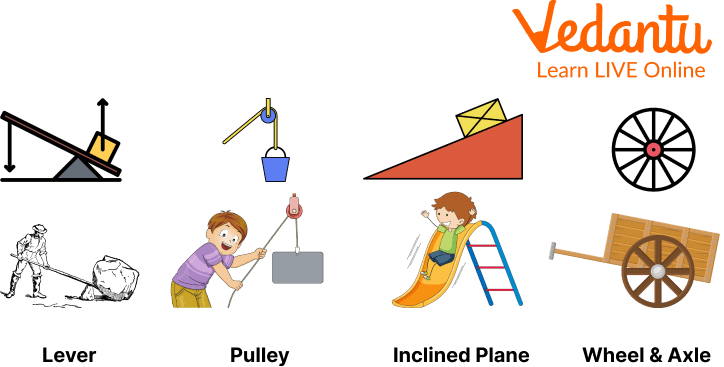
Simple Machines
Let’s See How Do Machines Help Us:
Lever: A lever is used to lift weights, cut things and open lids. Scissors and bottle-openers are examples of levers. A small child lifts a heavier child on a see-saw which is also a type of lever.
Pulley: A pulley is made from a wheel and a rope. It is used to lift things easily. For an example: Villagers use pulleys to draw water from wells. As from the below image it can be seen that a boy is pulling out water from the well by using pulley.

Use of Pulley in Daily Life
Wheel and Axle: A wheel-and-axle arrangement is made up of two circular objects of different sizes. The wheel is the larger object. It rotates around the smaller circular object called the axle. A steering wheel, a bicycle pedal and a screwdriver are some examples of wheel and axle. A steering wheel, a bicycle pedal and a screwdriver are some examples of wheel and axle. Bicycles, car tires, Ferris wheels, analogue clocks, electric fans, pizza cutters, windmills, drills, water wheels and door knobs are the simple axle and wheel machines that we use in daily life.
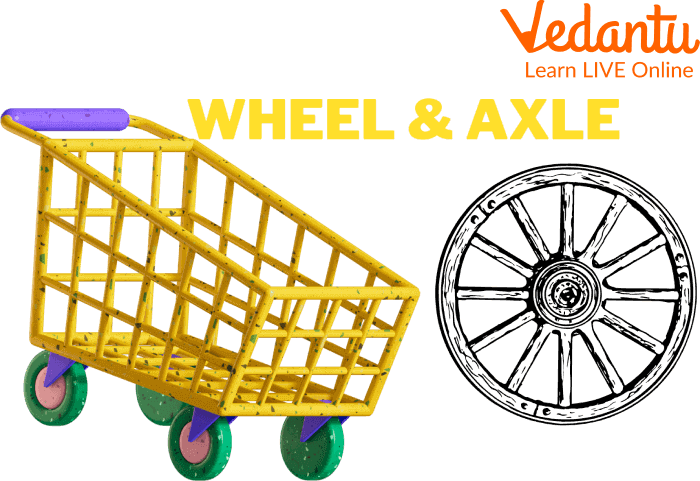
Wheel and Axle
Inclined Plane: An inclined plane is simply a slope over which a load can be pushed up or down. A plank of wood is often used to load heavy barrels onto trucks.
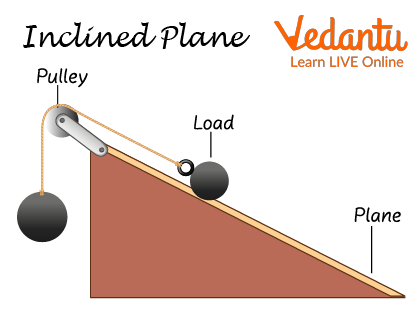
Inclined Plane
Compound Machines
Compound machines can be created by combining simple machines. Compound machines can range in size from a mechanical watch to a Wheelbarrow.
Following are the compound machine examples: Wheelbarrow, Pencil Sharpner, Clippers. To understand the examples of compound machines more clearly let’s see the below diagram.
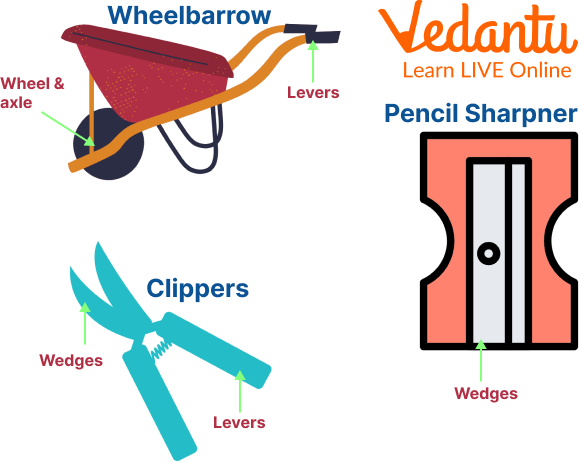
Examples of Compound Machines
Here, we can see that a wheelbarrow has more than one functionality in it. Similarly, clippers and pencil sharpener all of these have the combination of simple machines functionality.
Complex Machines
Combining simple and compound machines yields complex machines. They might be as small as a car or as massive as a construction crane. A complex machine is formed by the combination of two or more simple and compound machines. Compound machines are capable of doing more challenging tasks than simple machines alone.
Complex machines include bicycles, cranes, escalators, and so on. In the below complex machines images, we can see that each of the machines have more than 2 functionality. And that’s why it comes under the category of complex machines.
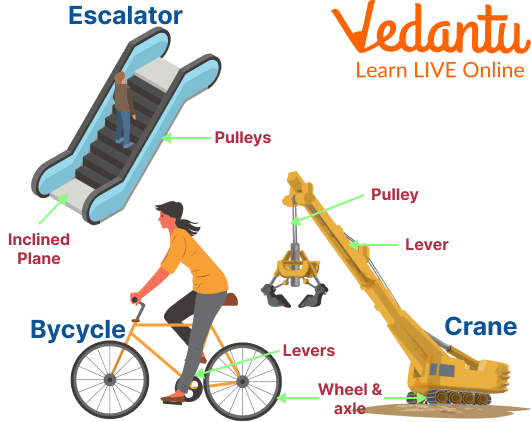
Complex Machines
Why do We Use Machines?
Following are the reasons we use machines:
Machines are utilised in a variety of industries to perform jobs that would take a human significantly longer to complete. Recent breakthroughs in automation and robotics have enabled large factories to be run entirely by automated machinery, with no human labour required.
Machines help us accomplish our jobs better as machines can often assist humans and we can collaborate with machines to complete things more quickly. Lawn mowing equipment, for example, can assist us trim lawn grass faster than we can manually.
Machines help to minimize work as machines allow us to work with less effort than we did previously. For e.g., farming equipment like the tractor and the harvester reduces the manual labour done by the farmers very significantly.
Summary
Machines are an essential part of our lives and play a vital role in the things we do every day. We use machines for everything from cooking food to filling up our gas tanks, and it is no surprise that these devices can be quite complex. In this article, we had discussed the different types of machines and also seen their examples. Finally, we explored the benefits of using machines and why they are such an important part of our everyday lives.
FAQs on Machines for Kids
1. What is a machine and how does it help us?
A machine is any tool that makes our work easier, faster, or better. Machines help us by either reducing the amount of force we need to use, changing the direction of our force, or increasing the speed at which we can do work. They are all around us, from a simple bottle opener to a complex computer.
2. What are the two main types of machines kids should learn about?
The two main types of machines are simple machines and compound machines. Simple machines are basic tools with few or no moving parts that make work easier (e.g., a ramp). Compound machines are made up of two or more simple machines working together to perform a task (e.g., a bicycle).
3. What are the six types of simple machines? Can you give an example for each?
The six classic simple machines make up the building blocks for most other machines. They are:
- Lever: A stiff bar that rests on a support called a fulcrum to lift or move things. Example: a see-saw or a crowbar.
- Wheel and Axle: A wheel with a rod (axle) through its centre that helps things move. Example: a doorknob or the wheels on a car.
- Pulley: A wheel with a groove for a rope, used to lift heavy objects. Example: a flagpole or window blinds.
- Inclined Plane: A flat, slanting surface that helps move objects to a different height. Example: a ramp or a slide.
- Wedge: An object with at least one slanting side ending in a sharp edge. It is used to separate two objects. Example: an axe or a knife.
- Screw: An inclined plane wrapped around a pole, used to hold things together or lift objects. Example: a jar lid or a light bulb.
4. What is a compound machine?
A compound machine (also called a complex machine) is a tool made from two or more simple machines that work together. For instance, a wheelbarrow is a compound machine because it uses a wheel and axle to roll and levers (the handles) to lift the load. Most of the machines we use every day are compound machines.
5. Is a pair of scissors a simple or a compound machine? Why?
A pair of scissors is a compound machine. It cleverly combines two different simple machines to work. The two handles and blades act as levers that pivot around a central screw (the fulcrum). The sharp cutting edges of the blades are sharpened into a wedge, which helps to push the paper apart as it cuts.
6. How do simple machines work together to create a compound machine like a bicycle?
A bicycle is an excellent example of a compound machine because it uses several simple machines:
- Wheels and Axles: The front and back wheels allow the bicycle to roll smoothly.
- Levers: The handlebars help you steer, and the brake handles are levers that pull the brake cables.
- Pulleys: The chain and gears act like a pulley system to transfer power from your legs to the back wheel.
- Screws: Many screws are used to hold all the different parts of the bicycle together firmly.
7. Why is a slide in a playground considered an inclined plane, and how does it make work easier?
A slide is a perfect example of an inclined plane. Instead of dropping straight down from a height (which would be very fast and dangerous), the slide provides a longer, sloped path. It makes the 'work' of getting to the ground easier by spreading the force of gravity over a greater distance. This reduces how steep the journey is, allowing you to move downwards in a safe and controlled way.
8. Do machines create energy, or do they just change how we use our own energy?
This is a great question that gets to the heart of how machines work. Machines do not create energy. They can only transfer or transform the energy we put into them. They make work feel easier by changing how a force is applied. For example, a ramp (inclined plane) lets you use less force over a longer distance to lift something. You do the same amount of work, but the machine allows you to do it in a more manageable way.









